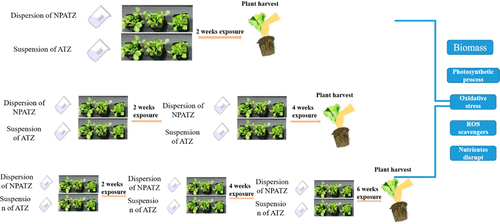当前位置:
X-MOL 学术
›
J. Agric. Food Chem.
›
论文详情
Our official English website, www.x-mol.net, welcomes your
feedback! (Note: you will need to create a separate account there.)
The Differences between the Effects of a Nanoformulation and a Conventional Form of Atrazine to Lettuce: Physiological Responses, Defense Mechanisms, and Nutrient Displacement
Journal of Agricultural and Food Chemistry ( IF 5.7 ) Pub Date : 2021-10-18 , DOI: 10.1021/acs.jafc.1c01382 Juan Wu 1 , Yujia Zhai 1 , Fazel Abdolahpur Monikh 1 , Daniel Arenas-Lago 2 , Renato Grillo 3 , Martina G Vijver 1 , Willie J G M Peijnenburg 1, 4
Journal of Agricultural and Food Chemistry ( IF 5.7 ) Pub Date : 2021-10-18 , DOI: 10.1021/acs.jafc.1c01382 Juan Wu 1 , Yujia Zhai 1 , Fazel Abdolahpur Monikh 1 , Daniel Arenas-Lago 2 , Renato Grillo 3 , Martina G Vijver 1 , Willie J G M Peijnenburg 1, 4
Affiliation

|
The rapid development of nanotechnology influences the developments within the agro-sector. An example is provided by the production of nanoenabled pesticides with the intention to optimize the efficiency of the pesticides. At the same time, it is important to collect information on the unintended and unwanted adverse effects of emerging nanopesticides on nontarget plants. Currently, this information is limited. In the present study, we compared the effects of a nanoformulation of atrazine (NPATZ) and the nonencapsulated atrazine formulation (ATZ) on physiological responses, defense mechanisms, and nutrient displacement in lettuce over time with the applied concentrations ranging from 0.3 to 3 mg atrazine per kg soil. Our results revealed that both NPATZ and ATZ induced significant decreases in plant biomass, chlorophyll content, and protein content. Additionally, exposure to NPATZ and ATZ caused oxidative stress to the lettuce plant and significantly elevated the activities of the tested ROS scavenger enzymes in plant tissues. These results indicate that NPATZ and ATZ cause distinct adverse impacts on lettuce plants. When comparing the adverse effects in plants after exposure to NPATZ and ATZ, no obvious differences in plant biomass and chlorophyll content were observed between NPATZ and ATZ treatments at the same exposure concentration regardless of exposure duration. An enhanced efficiency of the active ingredient of the nanopesticide as compared to the conventional formulation was observed after long-term exposure to the high concentration of NPATZ, as it induced higher impacts on plants in terms of the end points of the contents of protein, superoxide anion (O2̇–), and MDA, and the activities of stress-related enzymes as compared to the same concentration of ATZ. Furthermore, exposure to both NPATZ and ATZ disrupted the uptake of mineral nutrients in plants, and the differences in the displacement of nutrients between the NPATZ and ATZ treatments depended on the element type, plant organ, exposure concentration, and time. Overall, the application dose of a nanopesticide should balance their increased herbicidal efficiency with the long-term adverse effects in order to maximize the desired impact while minimizing adverse impacts; only then will we be able to understand the potential impact of nanopesticides on the environment.
中文翻译:

纳米制剂和传统形式的莠去津对生菜的影响差异:生理反应、防御机制和营养置换
纳米技术的快速发展影响着农业部门的发展。纳米杀虫剂的生产就是一个例子,目的是优化杀虫剂的效率。与此同时,收集有关新兴纳米农药对非目标植物的意外和不良不利影响的信息也很重要。目前,此信息有限。在本研究中,我们比较了莠去津纳米制剂 (NPATZ) 和非胶囊化莠去津制剂 (ATZ) 对生菜生理反应、防御机制和营养物质随时间推移的影响,应用浓度范围为 0.3 至 3 毫克莠去津每公斤土壤。我们的结果表明,NPATZ 和 ATZ 都会导致植物生物量、叶绿素含量和蛋白质含量显着降低。此外,暴露于 NPATZ 和 ATZ 会对生菜植物造成氧化应激,并显着提高植物组织中测试的 ROS 清除酶的活性。这些结果表明 NPATZ 和 ATZ 对生菜植物造成明显的不利影响。当比较暴露于 NPATZ 和 ATZ 后对植物的不利影响时,无论暴露时间长短,在相同暴露浓度下,NPATZ 和 ATZ 处理之间的植物生物量和叶绿素含量没有观察到明显差异。 长期暴露于高浓度的NPATZ后,与传统制剂相比,纳米农药活性成分的效率有所提高,因为它对植物的蛋白质、超氧化物含量终点产生了更高的影响与相同浓度的ATZ相比,阴离子(O 2 ̇ – )和MDA以及应激相关酶的活性。此外,暴露于 NPATZ 和 ATZ 都会扰乱植物对矿质养分的吸收,并且 NPATZ 和 ATZ 处理之间养分转移的差异取决于元素类型、植物器官、暴露浓度和时间。总体而言,纳米农药的施用剂量应平衡其增加的除草效率与长期不利影响,以最大限度地提高预期效果,同时最大限度地减少不利影响;只有这样我们才能了解纳米农药对环境的潜在影响。
更新日期:2021-10-27
中文翻译:

纳米制剂和传统形式的莠去津对生菜的影响差异:生理反应、防御机制和营养置换
纳米技术的快速发展影响着农业部门的发展。纳米杀虫剂的生产就是一个例子,目的是优化杀虫剂的效率。与此同时,收集有关新兴纳米农药对非目标植物的意外和不良不利影响的信息也很重要。目前,此信息有限。在本研究中,我们比较了莠去津纳米制剂 (NPATZ) 和非胶囊化莠去津制剂 (ATZ) 对生菜生理反应、防御机制和营养物质随时间推移的影响,应用浓度范围为 0.3 至 3 毫克莠去津每公斤土壤。我们的结果表明,NPATZ 和 ATZ 都会导致植物生物量、叶绿素含量和蛋白质含量显着降低。此外,暴露于 NPATZ 和 ATZ 会对生菜植物造成氧化应激,并显着提高植物组织中测试的 ROS 清除酶的活性。这些结果表明 NPATZ 和 ATZ 对生菜植物造成明显的不利影响。当比较暴露于 NPATZ 和 ATZ 后对植物的不利影响时,无论暴露时间长短,在相同暴露浓度下,NPATZ 和 ATZ 处理之间的植物生物量和叶绿素含量没有观察到明显差异。 长期暴露于高浓度的NPATZ后,与传统制剂相比,纳米农药活性成分的效率有所提高,因为它对植物的蛋白质、超氧化物含量终点产生了更高的影响与相同浓度的ATZ相比,阴离子(O 2 ̇ – )和MDA以及应激相关酶的活性。此外,暴露于 NPATZ 和 ATZ 都会扰乱植物对矿质养分的吸收,并且 NPATZ 和 ATZ 处理之间养分转移的差异取决于元素类型、植物器官、暴露浓度和时间。总体而言,纳米农药的施用剂量应平衡其增加的除草效率与长期不利影响,以最大限度地提高预期效果,同时最大限度地减少不利影响;只有这样我们才能了解纳米农药对环境的潜在影响。











































 京公网安备 11010802027423号
京公网安备 11010802027423号